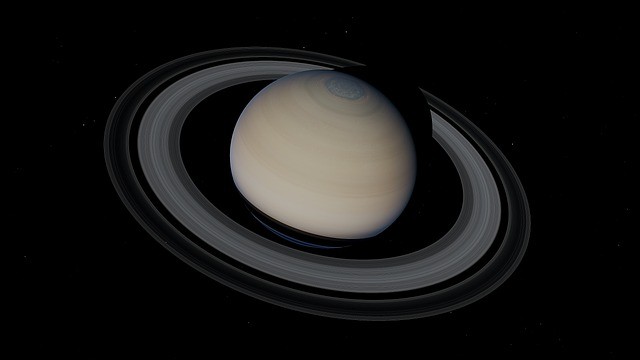In this article we present you some facts about the Planet Saturn
Saturn is the sixth planet from the Sun and the second-largest in the Solar System.
It is a gas giant with an average radius of about nine times that of Earth. It only has one-eighth the average density of Earth; however, with its larger volume, Saturn is over 95 times more massive. Saturn is named after the Roman god of wealth and agriculture; its astronomical symbol (♄) represents the god’s sickle.
Saturn’s interior is most likely composed of a core of iron–nickel and rock. Its core is surrounded by a layer of metallic hydrogen, a layer of liquid hydrogen and liquid helium, and then a gaseous outer layer. Saturn has a pale yellow hue due to the presence ammonia crystals in its upper atmosphere.

An electrical current within the metallic hydrogen layer is thought to give rise to Saturn’s planetary magnetic field, which is weaker than the Earth’s, but which has a magnetic moment 580 times that of Earth due to Saturn’s size. Wind speeds on Saturn can reach up to 1,800 km/h.
The planet’s most famous feature is its prominent ring system, which is composed mostly of ice particles, with a smaller amount of rocky debris and dust. At least 82 moons are known to orbit Saturn, of which 53 are officially named.
Saturn Facts
Saturn is named after the Roman god of agriculture.
Saturn is nicknamed the “Ringed Planet”.
The first person to observe Saturn through a telescope was Galileo Galilei.
Saturn is the second largest planet in our solar system.
Saturn is the sixth planet from the Sun.
Saturn has a radius of 58,232 kilometers.
Saturn has a diameter of 120,536 kilometers.
Saturn is 1,424,600,000 km from the Sun.
Light takes about 1 hour and 29 minutes to travel from Saturn and then arrive at us.
The interior of Saturn is very hot, reaching temperatures of up to 11,700°C
It takes Saturn 29.4 Earth years to orbit the Sun.
There are at least 82 moons orbiting the planet Saturn.
20 new moons were discovered in 2019.
Its largest moon Titan is the 2nd largest moon in the entire solar system.
Saturn is the farthest planet from Earth that is visible to the naked eye.
Saturn could hold 760 Earths.
The surface area of Saturn is 83 times greater than Earth.
Saturn spins so fast that it bulges at its equator.
Saturn is the second fastest spinning planet following Jupiter.
The temperature on Saturn’s upper atmosphere is on average at around -175 degrees Celsius.
The magnetic field of Saturn is approximately 578 times stronger than Earth’s magnetic field.
Saturn has the lowest density of all the planets.
It is lighter than water.
Saturn has the fastest winds of any other planet in our solar system.
These winds have been measured at approximately 1,800 km per hour.
Saturn is the flattest of the eight planets.
It takes Saturn 10 hours and 34 minutes to turn on its axis.
Saturn’s atmosphere is composed of roughly 96% hydrogen and 4% helium.
The atmosphere has also ammonia, acetylene, ethane, phosphine and methane.
It has a thickness of approximately 60 km.
Saturn appears a pale yellow color because its upper atmosphere contains ammonia crystals.
The magnetic field on Saturn is slighter weaker than Earth’s magnetic field.
Scientists believe it has a solid rocky core surrounded by hydrogen and helium.
Saturn has the most extensive rings in the solar system.
Saturns rings are made mostly of chunks of ice and small amounts of carbonaceous dust.
The rings stretch out more than 120,700 km from the planet.
The rings are only about 20 meters thick.
Saturn’s ring system is divided into 7 groups.
Scientists believe that Saturn will lose its rings in about 100 million years.
Four spacecraft have visited Saturn.
Saturn emits approximately 2.5 times more radiation than it receives from the Sun.

1 comment
[…] We have facts about Staurn right here for you – Various facts about the planet Saturn […]
Comments are closed.